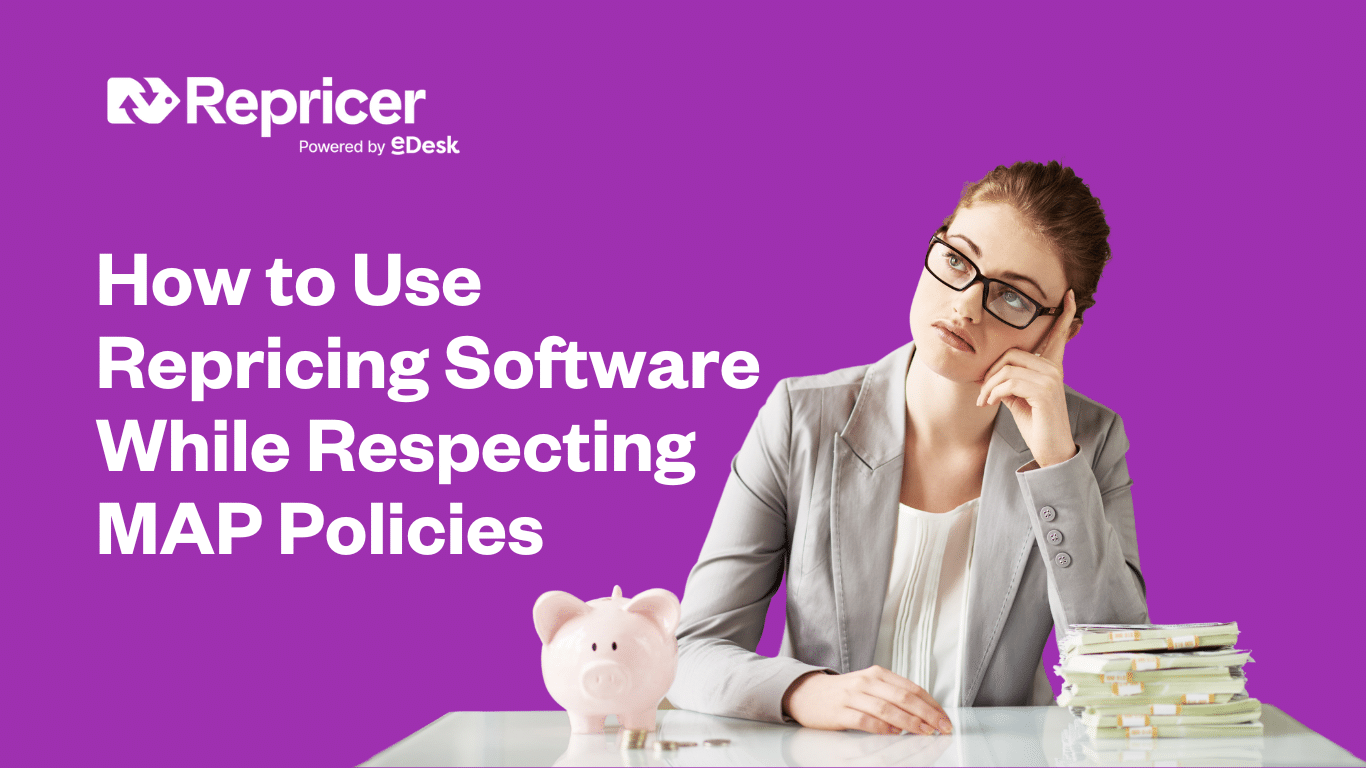Picture this: You’ve just implemented a powerful repricing tool to stay competitive in today’s fast-paced e-commerce environment, only to receive an angry email from a manufacturer threatening to revoke your selling privileges for violating their MAP policy. Sound familiar? You’re not alone. With the pricing software market growing at a remarkable 11.6% CAGR and reaching $1.15 billion in 2025, more businesses are turning to automated pricing solutions. However, this surge in automation has also led to an increase in unintentional MAP violations, making it crucial for sellers to understand how to leverage repricing technology while staying compliant.
Bottom Line Up Front: Repricing software can be your best friend or worst enemy when it comes to MAP compliance. The key is configuring your tools correctly with proper price floors, exclusion settings, and accurate cost data to automate competitive pricing while respecting manufacturer pricing rules.
What Is MAP and Why Does It Matter?
Minimum Advertised Price (MAP) policies are agreements between manufacturers and their authorized resellers that establish the lowest price at which products can be advertised publicly. Think of MAP as a protective boundary that helps maintain brand value and ensures fair competition among retailers.
MAP policies don’t control your actual selling price, but they do regulate how you advertise that price. For instance, you might sell a product for $89, but if the MAP is $99, you can only advertise it at $99 or higher. The final discounted price can be revealed through “add to cart” pricing or similar mechanisms.
These policies have become increasingly important in 2025’s competitive landscape. According to recent industry analysis, manufacturers are focusing more heavily on MAP enforcement due to the rapid price fluctuations possible in e-commerce environments, where prices can change multiple times daily. The rise of online marketplaces has made MAP monitoring both more challenging and more essential for brand reputation management.
The Hidden Risks of Automated Repricing
Automated repricing tools are incredibly powerful, but they can quickly become liability machines if not configured properly. Here’s what can go wrong:
Speed vs. Compliance Trade-off Your repricing software might react to competitor price changes within minutes, automatically lowering your advertised prices below MAP thresholds before you even know what happened. While speed gives you competitive advantages, it can also lead to rapid-fire violations.
Lack of Product-Specific Rules Many sellers configure their repricing tools with blanket rules across their entire catalog. This approach ignores the fact that different products may have different MAP requirements, authorized seller agreements, or manufacturer pricing rules. A one-size-fits-all strategy often leads to violations.
Competitor Data Confusion Your repricing tool might be following unauthorized sellers who aren’t bound by MAP policies, or it could be misinterpreting promotional pricing from authorized dealers as regular market pricing. This creates a race to the bottom that violates your MAP agreements.
The Violation Snowball Effect Once your repricing software starts violating MAP policies, it often triggers a cascade of problems. Other sellers might follow your lead, manufacturers lose trust in your brand partnership, and you might face selling privilege suspensions just when peak selling seasons arrive.
Setting Up MAP Policy Compliant Repricer Configuration
Successfully avoiding map violations when repricing requires a strategic approach to your repricing tool setup. Here’s how to configure your system for compliance:
Establish Rock-Solid Price Floor Settings
Your minimum advertised price automation starts with setting appropriate price floors for every product subject to MAP policies. Never rely on cost-based floors alone; these need to reflect actual MAP requirements.
Product-Level MAP Floors Import your manufacturer MAP data directly into your repricing system and set individual price floors for each SKU. Your MAP policy-compliant repricer should treat these floors as absolute boundaries that cannot be crossed, regardless of competitive pressure or algorithm recommendations.
Category-Based Backup Rules For products without specific MAP data, establish conservative category-level minimums based on typical manufacturer pricing guidelines within each product category. This prevents accidental violations for new products or items with unclear MAP status.
Configure Smart Exclusion Settings
Not every product in your catalog should be subject to aggressive repricing below map strategies. Set up exclusion rules for:
- Products with known MAP policies
- Items from manufacturers with strict brand pricing guidelines
- High-value products where violations could trigger account suspension
- New product launches during their initial selling periods
Implement Competitor Filtering
Your repricing algorithm should only follow pricing data from verified authorized sellers. Configure your system to exclude:
- Sellers without proper authorization documentation
- Accounts with frequent MAP violations
- International sellers who may not be subject to US MAP policies
- Liquidation or closeout sellers offering below-MAP pricing
Leveraging Repricer Features for Safe Operations
Modern repricing platforms offer sophisticated features designed to help with brand reputation management and compliance. Here’s how to use them effectively:
Min/Max Price Controls
The Repricer Features include robust minimum and maximum price controls that act as safety nets for your pricing automation. Set your maximum prices to prevent profit margin erosion, and your minimums to ensure MAP compliance across all channels.
Safe Mode Activation
When in doubt, activate Safe Mode for products with complex MAP requirements. This feature typically slows down repricing frequency and requires manual approval for significant price changes, giving you time to verify compliance before changes go live.
Advanced Repricing Strategies
Explore different Repricing Strategies that prioritize compliance over aggressive pricing. Conservative strategies might sacrifice some competitive positioning but protect your long-term selling relationships and brand partnerships.
The Critical Role of Accurate Cost Data
Your repricing success depends heavily on having accurate, up-to-date cost information for every product. Here’s why this matters for MAP compliance:
Margin Protection Accurate cost data helps you set minimum prices that not only respect MAP policies but also protect your profit margins. Without reliable cost information, you might set floors too low and end up selling products at break-even or loss levels.
Dynamic Cost Updates Product costs change frequently due to supplier price adjustments, currency fluctuations, and quantity discount tiers. Implement systems to regularly update your cost data so your minimum advertised price automation reflects current economics.
Total Cost Calculations Include all relevant costs in your calculations, including shipping to your warehouse, storage fees, marketplace commissions, and processing costs. This comprehensive view helps you set realistic price floors that maintain profitability while respecting manufacturer pricing rules.
Monitoring and Enforcement Best Practices
Setting up your system correctly is just the beginning. Ongoing monitoring ensures continued compliance:
Daily Violation Checks Implement daily scans of your advertised prices against current MAP requirements. The pricing software market’s growth to $1.15 billion in 2025 reflects increasing sophistication in monitoring tools that can automate this process.
Manufacturer Communication Maintain open communication channels with your manufacturer partners about your repricing approach. Many suppliers appreciate transparency about your automated systems and can provide guidance on proper implementation.
Documentation and Audit Trails Keep detailed records of your MAP compliance efforts, including system configurations, violation responses, and manufacturer communications. This documentation protects you during disputes and demonstrates good faith compliance efforts.
Regular System Audits Schedule quarterly reviews of your repricing configurations to ensure they still align with current MAP policies and authorized seller agreements. Manufacturer requirements can change, and your system needs to evolve accordingly.
Balancing Competitiveness with Compliance
The most successful sellers find ways to remain competitive while respecting MAP policies:
Focus on Value-Added Services When you can’t compete on advertised price, compete on shipping speed, customer service, bundled offerings, or extended warranties. These differentiators don’t violate MAP policies but still attract customers.
Optimize Non-MAP Products Concentrate your most aggressive repricing strategies on products without MAP restrictions. This allows you to maintain competitive positioning in part of your catalog while staying compliant elsewhere.
Seasonal Strategy Adjustments During peak selling seasons, prioritize MAP compliance over short-term competitive gains. The long-term cost of losing manufacturer partnerships far exceeds temporary revenue increases from MAP violations.
Legal Considerations and Risk Management
Understanding the legal landscape around MAP policies helps you make informed decisions:
MAP vs. Price Fixing MAP policies are generally legal when properly implemented, but they must be unilateral policies imposed by manufacturers, not agreements between competitors. Familiarize yourself with these distinctions to avoid antitrust issues.
State-by-State Variations Some states have specific laws governing MAP enforcement and resale price maintenance. Ensure your repricing strategies comply with applicable state regulations in your key markets.
Terms and Conditions Compliance Review your marketplace and supplier Terms and Conditions regularly to understand how MAP violations might affect your account standing and selling privileges.
Technology Solutions for Advanced MAP Management
The latest repricing technology offers sophisticated MAP management capabilities:
AI-Powered Compliance Checking Advanced systems use artificial intelligence to automatically identify potential MAP violations before they occur, analyzing competitor pricing patterns and manufacturer policy changes in real-time.
Integration with MAP Monitoring Tools Many repricing platforms now integrate directly with specialized MAP monitoring tools, creating seamless workflows that protect compliance while maintaining competitive positioning.
Automated Manufacturer Reporting Some systems can automatically generate compliance reports for manufacturers, demonstrating your commitment to policy adherence and building stronger partnership relationships.
Key Takeaways for MAP-Compliant Repricing
To successfully avoiding map violations, repricing requires a combination of proper tool configuration, accurate data, and ongoing vigilance. Remember these essential points:
- Set absolute price floors based on actual MAP requirements, not just cost-based calculations
- Configure exclusion rules for products with strict manufacturer pricing guidelines
- Filter competitor data to follow only authorized sellers with proper brand pricing guidelines
- Maintain accurate cost data to support both profitability and compliance
- Monitor daily for violations and respond quickly to any issues
- Document everything to demonstrate good faith compliance efforts
The repricing software market’s rapid growth reflects the competitive pressures all sellers face, but successful businesses understand that short-term price advantages never justify long-term manufacturer relationship damage. By implementing proper MAP policy compliant repricer configurations and maintaining vigilant oversight, you can harness the power of automated pricing while building sustainable, compliant business practices.
Your repricing strategy should serve your long-term business goals, not just immediate competitive pressures. When configured correctly with appropriate safeguards and monitoring, repricing software becomes a powerful tool for growth rather than a source of compliance headaches.
Ready to implement MAP-compliant repricing for your business? Start by auditing your current minimum advertised price automation settings and ensuring you have accurate cost data for every product. Remember, the most successful sellers are those who build sustainable competitive advantages through compliance, not violations.





